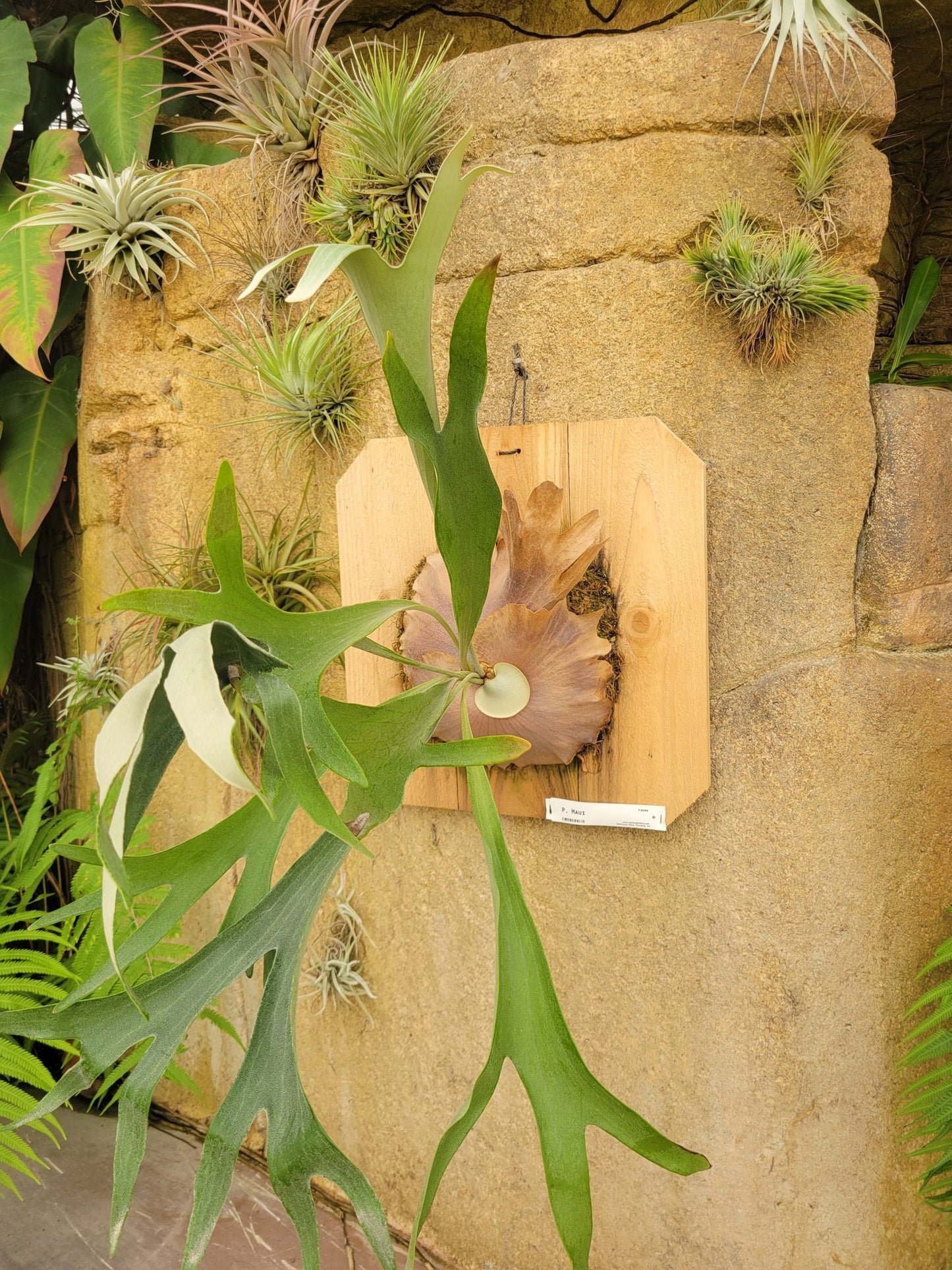Absolutely! Here’s a 3000-word article about Platycerium bifurcatum, incorporating your request to replace list items with H2 and H3 headers.

Image Source: wikimedia.org
The Staghorn Fern’s most striking feature is its two distinct types of fronds:
Basal (Shield) Fronds: The Foundation of Life
These broad, kidney-shaped fronds are the base of the plant, clinging tightly to the supporting surface. Initially green, they mature into a brown, papery texture, forming a protective shield that captures falling debris and moisture. They are crucial for the fern’s nutrient and water absorption.

Image Source: rainforestflora.com
Fertile Fronds: The Antlered Glory
These are the iconic, forked fronds that give the Staghorn Fern its name. They emerge from the basal fronds and can grow to significant lengths, displaying a characteristic forked or branched appearance. The undersides of these fronds are where the sori, or spore-producing structures, are located.
Sori: The Reproductive Powerhouse
The sori appear as brown patches on the undersides of the fertile fronds. They contain the sporangia, which release spores for reproduction. The pattern and arrangement of sori are important for identifying different Platycerium species.
Growing Platycerium bifurcatum successfully requires understanding its natural habitat and replicating those conditions as closely as possible.
Mounting: Mimicking Natural Growth
The most common and aesthetically pleasing method is mounting the fern on a plaque of wood, a piece of cork bark, or even a tree fern slab. This replicates its epiphytic growth habit.
Choosing the Right Mount
Select a rot-resistant material like cedar, redwood, or treated lumber. Cork bark and tree fern slabs are also excellent choices.
Securing the Fern
Use fishing line, nylon string, or plant ties to secure the fern to the mount. Avoid metal wires, which can rust and damage the plant.
Substrate: Providing Essential Nutrients
While Platycerium bifurcatum obtains nutrients from the air and debris, a suitable substrate is necessary for initial establishment and continued health.
Sphagnum Moss: A Moisture-Retaining Medium
Sphagnum moss is an excellent choice for mounting Platycerium bifurcatum. It retains moisture and provides a stable base for the fern’s roots.
Coarse Orchid Mix: Enhancing Drainage
A coarse orchid mix, consisting of bark, perlite, and charcoal, can be used to improve drainage and aeration.
Watering: Balancing Moisture and Aeration
Proper watering is crucial for the Staghorn Fern’s health. Overwatering can lead to root rot, while underwatering can cause dehydration.
Soaking Method: Thorough Hydration
The best method is to soak the entire mount in water for 10-15 minutes, allowing the sphagnum moss and basal fronds to absorb moisture.
Frequency: Adapting to Environmental Conditions
Watering frequency depends on temperature, humidity, and airflow. In warmer, drier conditions, more frequent watering is necessary.
Light: Providing Ample Illumination
East or North-Facing Windows: Ideal Indoor Placement
Indoors, an east or north-facing window provides optimal light.
Shade Cloth: Protecting from Intense Sunlight
Outdoors, provide shade during the hottest parts of the day using shade cloth or placing the fern under the canopy of a tree.
Humidity: Replicating Rainforest Conditions
High humidity is essential for the Staghorn Fern’s health.
Misting: Increasing Ambient Humidity
Regular misting, especially during dry periods, helps maintain adequate humidity.
Humidifier: Providing Consistent Moisture
A humidifier can be used to increase humidity in dry indoor environments.
Fertilization: Supplementing Nutrients
While Platycerium bifurcatum obtains nutrients from decaying organic matter, occasional fertilization can promote healthy growth.
Diluted Orchid Fertilizer: Gentle Nourishment
Use a diluted orchid fertilizer, applied sparingly during the growing season (spring and summer).
Foliar Feeding: Direct Nutrient Absorption
Foliar feeding, spraying a diluted fertilizer solution directly onto the fronds, can be beneficial.
Spore Propagation: A Patient Process
Spore propagation is a slow and challenging process but can yield numerous new plants.
Collecting Spores
Collect mature spores from the undersides of fertile fronds when they are brown and powdery.
Sowing Spores
Sow the spores on a moist sphagnum moss or peat moss surface in a humid environment.
Growing Sporophytes
It can take several months for the spores to germinate and develop into sporophytes.
Offset Division: A Faster Method
Offsets, or pups, are small plants that grow from the base of the mature plant.
Separating Offsets
Carefully separate the offsets when they are large enough to have their own roots and shield fronds.
Mounting Offsets
Mount the offsets on a suitable substrate, following the same guidelines as for mature plants.
Root Rot: The Peril of Overwatering
Overwatering is the primary cause of root rot, leading to yellowing and wilting fronds.
Improving Drainage
Ensure proper drainage by using a well-draining substrate and allowing the mount to dry slightly between waterings.
Scale Insects: Sap-Sucking Pests
Scale insects are small, sap-sucking pests that can weaken the fern.
Manual Removal
Remove scale insects manually using a cotton swab dipped in rubbing alcohol.
Insecticidal Soap
Apply insecticidal soap to control severe infestations.
Brown Fronds: Signs of Stress
Brown fronds can indicate various issues, including underwatering, low humidity, or sunburn.
Addressing Underlying Issues
Identify and address the underlying cause to prevent further damage.
platycerium bifurcatum
